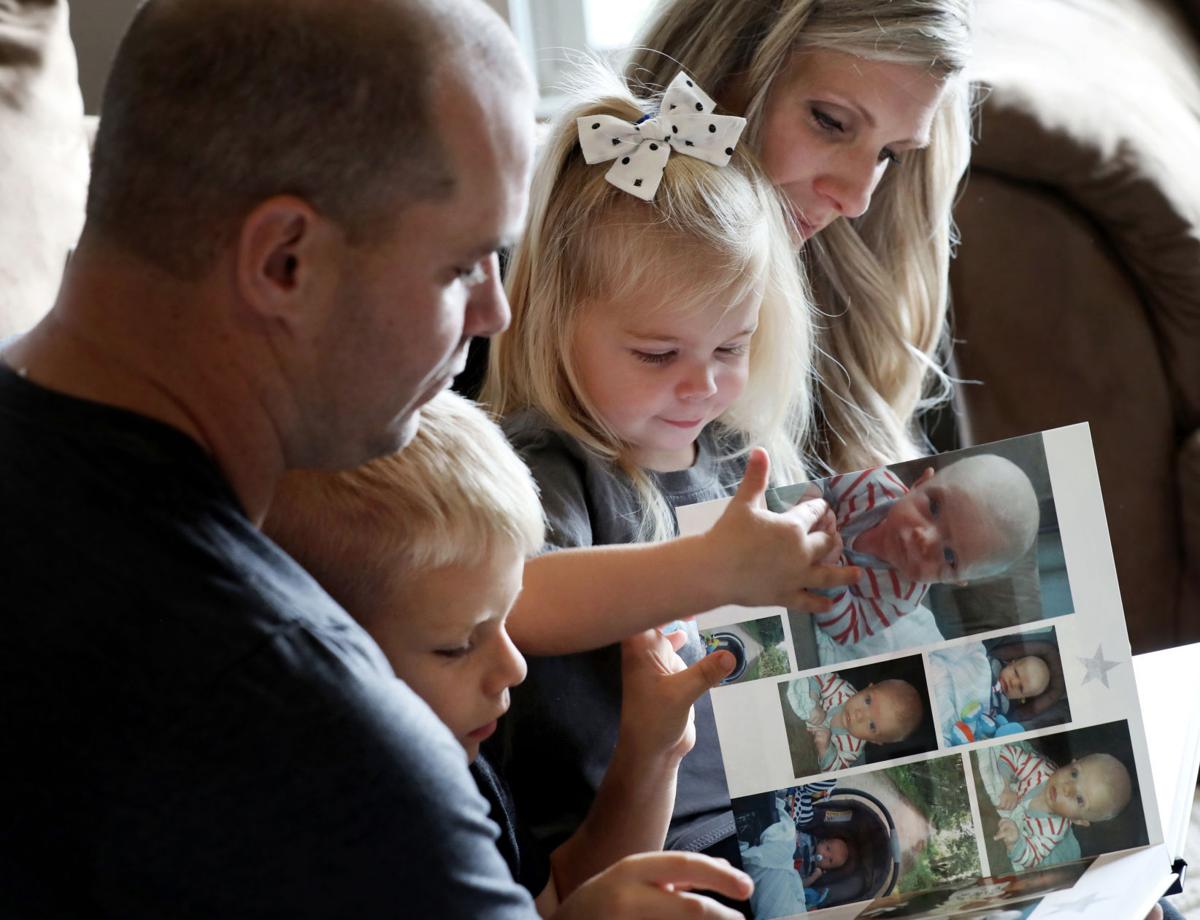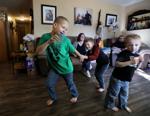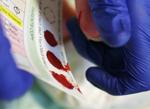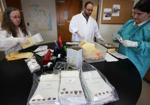[ad_1]
With blue eyes and a tuft of blond hair, Jenna and Kyle Heckendorf’s first child, Bryce, seemed healthy, smiling and giggling during a family vacation at a lake resort.
Jenna and Kyle Heckendorf lost their son, Bryce, to Krabbe disease seven years ago when he was 18 months old
But shortly after he turned 5 months old, he started eating less. His arms and legs became rigid. When placed on his stomach, he would wail.
He was diagnosed with Krabbe disease, an inherited disorder that causes muscle weakness and other problems, typically becoming fatal by age 2.
“They handed us tissues and said, ‘We’ll help you keep him comfortable as he passes away,’” said Jenna Heckendorf, a teacher from Spring Green, whose son died at 18 months old seven years ago after being on a feeding tube and an oxygen machine.
Ten states test infants for Krabbe (pronounced crab-AY), using a few drops of blood collected from their heels a day or two after birth for routine newborn screening. Families whose babies have the condition can try stem cell transplants, which studies show can lead to longer and more normal lives if done within 30 days, before symptoms appear.
Wisconsin has twice rejected adding Krabbe to its newborn screening program. State officials say it’s not clear how babies would be sent out of state to the few centers that do the risky transplants for infants with the condition. A bill before the state Legislature would circumvent Wisconsin’s scientific committee process for evaluating conditions and require the state to test babies for Krabbe.
“We wish we would have had that option,” Heckendorf said of a transplant. “It gives you hope … versus being told there’s nothing you can do.”
Nationwide, newborn screening has tested babies for rare diseases that are unnoticeable at birth but treatable since the mid-1960s, with some states checking for only a few disorders in the initial decades and others detecting many. Despite a federal effort to make testing more consistent in 2010, states still choose which conditions to add, and considerable variation remains.
Connecticut screens for 73 diseases, while Hawaii looks for 28, according to the federal Health Resources and Services Administration, or HRSA. California and Tennessee test for 67 disorders, while Louisiana does 30 and Alabama, Arizona and Arkansas do 31, the agency says. Wisconsin’s panel includes 47 disorders.
Debates over cost, the prevalence and severity of an illness, the effectiveness of treatments and false positive results account for much of the disparity, said Natasha Bonhomme, director of Baby’s First Test, a newborn screening education center in Washington, D.C. Some states require legislative approval to add conditions, and others rely on doctors, with varying levels of public input.
States name and count some conditions differently, so the magnitude of differences is hard to pin down, Bonhomme said.
“If you see one state is screening for 30-some conditions and another state is screening for 60-some conditions, the variation may not actually be a difference of 30 but there is going to be a difference,” Bonhomme said.
Federal recommendations
In 2010, the federal government adopted a Recommended Uniform Screening Panel, or RUSP. It currently lists 35 conditions states should screen for and 26 other disorders that can be picked up when testing for the core group.
“We continue to push for states to definitely provide all 35 of the core screenings,” said Stacey Brayboy, a senior vice president at the March of Dimes, which has long promoted newborn screening.
Some disorders on the list are relatively well known, such as cystic fibrosis and sickle cell disease, but most are unfamiliar and have complicated names. With most, each parent is an unaffected carrier — usually, unknowingly — and each of their children has a 25% chance of getting the disease.
The prevalence of the conditions ranges from roughly 1 in 3,000 babies to 1 in 300,000. Combined, when hearing loss is included, about 1 in 300 newborns, or nearly 13,000 U.S. babies a year, has one of the disorders.
The diseases typically can be treated with special diets, therapies such as enzyme infusions or procedures such as stem cell transplants. In most cases, doctors say early treatment is essential to prevent death or disability.
Missing early treatment
Wisconsin screens for 32 of the 35 core conditions. The state doesn’t test for Pompe disease, which disables the heart and skeletal muscles, and was added to the RUSP in 2015. It doesn’t screen for mucopolysaccharidosis type 1, or MPS 1, a disease that affects many parts of the body, or X-linked adrenoleukodystrophy, also called X-ALD, which gained attention in the 1992 film “Lorenzo’s Oil.” Both were added to the RUSP in 2016.
Twenty-seven states screen for Pompe, 26 test for MPS 1 and 22 look for X-ALD, according to NewSTEPs, a resource center run by the Association of Public Health Laboratories.
The Wisconsin Department of Health Services approved adding Pompe (pom-PAY) in May 2020, and the testing is scheduled to begin Jan. 10. Committees are looking at adding X-ALD and have discussed MPS 1, but for now aren’t pursuing it.
In a pilot project, Wisconsin screened babies for Pompe from July 2017 to March 2019. No cases of the severe infantile form of the disease were found, but 13 babies were identified as having a less-serious, later-onset form. The state has more than 60,000 births a year.
In June 2016, Genevieve and Austin Faucher of Oshkosh welcomed their first child, Atlas. He seemed fragile and floppy, which doctors attributed to being born five weeks early. When the boy developed a persistent cough, his mother demanded a chest X-ray.
The scan found a significantly enlarged heart. Atlas, by then nearly 4 months old, was taken by helicopter to Children’s Wisconsin hospital near Milwaukee, where six days later tests revealed he had infantile Pompe. He started on an enzyme therapy that can slow the worsening of symptoms, but it doesn’t reverse deterioration that already occurred.
“That’s months of (disease) progression, of damage that he can’t get back,” Genevieve Faucher said.
Atlas, 5, is fed through a tube and uses a wheelchair. He speaks in muffled words that can be hard to understand. Seven nurses rotate caring for him on weekdays, and his working parents handle weeknights and weekends.
Since he is susceptible to complications from infections, Atlas attends kindergarten online. He receives physical therapy, occupational therapy, speech therapy and breathing treatments, which are mostly covered by Medicaid. A fan of the Disney movies “Aladdin” and “Cinderella,” he likes to spin his wheelchair on the family’s hardwood floors to the soundtrack of the 2020 film “Zombies 2.”
With a 3-year-old sister and an 18-month-old brother who don’t have Pompe, comparisons are hard to accept. When his brother took his first steps, “Atlas got so mad, he started yelling at him and said, ‘You’re not allowed to walk,’” their mother said.
Atlas Faucher, 5, was diagnosed with Pompe disease at 4 months old
Atlas’ future, and longevity, are “a big old question mark,” Faucher said.
If Pompe had been part of newborn screening when Atlas was born, he could have started treatment earlier and almost certainly would have fewer disabilities, she said. For babies born with the condition today, “it could literally save people like Atlas’ lives,” she said.
In Wisconsin, experts appointed by the state health department vote on adding conditions to newborn screening before consideration by a larger committee that meets twice a year.
Another panel, the Secretary’s Advisory Committee on Newborn Screening, considers nine criteria, including how accurate tests are and whether treatment is readily available, before making its recommendation to the health department. The department’s rulemaking process to add a condition can take 30 months, spokesperson Jennifer Miller said.
Newborn screening is considered mandatory in all states, though in Wisconsin and many states parents can opt out for religious beliefs or personal convictions. About 99% of babies in the state are screened, said Dr. Mei Baker, co-director of newborn screening at the Wisconsin State Laboratory of Hygiene.
Positive results typically require follow-up testing to confirm a diagnosis, Baker said. False positives can alarm parents, and treatments need to be effective enough to justify early identification of the disease, she said.
“If you list a condition, you also attach an obligation,” Baker said.
More from this series:
Krabbe screening
New York was the first state to start screening for Krabbe, in 2006, after former Buffalo Bills quarterback Jim Kelly’s son, Hunter, died from the condition the previous year. Missouri added Krabbe to newborn screening in 2012, followed by Kentucky and Ohio in 2016, Tennessee and Illinois in 2017, New Jersey in 2019, Indiana in 2020 and Pennsylvania and Georgia this year, according to the nonprofit Hunter’s Hope, started by Kelly.
When Wisconsin first refused to add Krabbe in 2016, state experts said there were too many false positives, and stem cell transplants weren’t clearly effective. The federal committee overseeing the RUSP voted against adding Krabbe seven years earlier for similar reasons.
During Wisconsin’s second review of Krabbe last year, the secretary’s advisory committee said testing had improved, with the false positive rate “near zero.” A stem cell transplant still “does not fully treat or cure the disease,” according to the committee, which said only a few centers do transplants for babies with Krabbe, notably Duke University in North Carolina.
This February, health department Secretary Karen Timberlake ruled against adding Krabbe, saying follow-up procedures and referral centers need to be identified. In July, Hunter’s Hope re-nominated Krabbe at the federal level. The review process could take at least a year.
Dr. Joanne Kurtzberg, who has done 57 stem cell transplants for Krabbe at Duke since 1996, published a paper on the earliest patients in 2018. The report said 79% were alive 10 years after the procedures and those transplanted before 30 days moved, spoke and fed better than those transplanted later.
In an interview, Kurtzberg said about a third of the patients end up needing a wheelchair, another third walk with difficulty and another third are minimally impaired, including a 17-year-old who takes dance classes. “If you met her on the street, you would never know,” she said.
Early this year, Dr. Kristin Page, who trained under Kurtzberg, moved to the Medical College of Wisconsin near Milwaukee. Page has had “preliminary conversations” about starting stem cell transplants for Krabbe, said Evan Solocheck, a spokesperson for the affiliated Children’s Wisconsin hospital.
A difficult life
Toys, blankets and pillows, including one stuffed with their son’s hair, are strewn across a hospital bed in Judy and Kevin Cushman’s living room in Wisconsin Rapids.
It has been nearly two years since Collin Cushman died from Krabbe at age 8, but the couple can’t bring themselves to get rid of the bed or his breathing machines stored beneath it. For most of his life, Collin couldn’t walk, talk, see or eat. He lived on the bed.
“It was months and months before I would spend much time in this room,” Kevin Cushman said, his voice quivering.
Judy studied a photo of Collin waving as she held him on a slide when he was 9 months old. “This was one of his last waves,” she said.
Soon after, Collin became irritable, had trouble sitting up and clenched his fists. Four months of testing led to the diagnosis of Krabbe.
“You go into shock, denial, anger, all those stages of grief,” Kevin said.
The couple persisted as parents, including with a healthy daughter born four years after Collin. They traded shifts watching over their son and worked with his phalanx of nurses. All the while, they wondered how life might have been different if Collin had been tested for Krabbe at birth, in time for a transplant.
“To have a child who could have sleepovers, who could go to sleepovers, who could live somewhat of a normal life, would be huge,” Kevin said.
They approached state Sen. Patrick Testin, R-Stevens Point, who in March introduced the bill to require Wisconsin to screen for Krabbe. Testin amended the bill to make the state start Krabbe testing when it begins screening for Pompe, which involves a similar test. That way, it would bring little or no additional cost, state officials said.
Dr. Robert Steiner, newborn screening consultant for the state health department, expressed concern about deviating from the state’s reliance on scientific committees. The process aims to “be sure that there will be an overall benefit to families and society, and to avoid negative or unintended impacts,” he said.
Living with Krabbe
On a recent afternoon, Jeremy Thoms shifted his body from his wheelchair to an easy chair between his parents’ recliners at their home in Eau Claire. He began to sing, joining in a Josh Groban recording on YouTube.
“You raise me up, so I can stand on mountains,” Jeremy bellowed off-key, while imparting the inspiration of the song. “You raise me up, to walk on stormy seas.”
Lego sets, with Harry Potter, Batman and dinosaur themes, covered much of the floor. At night, Jeremy lines up the dinosaurs so they stare at his father, a running joke.
Jeremy, 21, is in his sixth year of high school by choice. He is slow to speak but can converse. Why Batman over Superman? “Batman doesn’t have super powers,” he said. “He’s a hero no matter what.”
Jeremy was diagnosed with Krabbe when he was 8 days old. Kurtzberg gave him a transplant at 28 days. Tanys and Randy Thoms had Jeremy tested because their first son, Alex, died from Krabbe at 13 months. Their middle son, Adam, 33, is not affected.
Jeremy walked on his own until he was 5, when he started using a walker. He has relied on a wheelchair since he was 10. A few years ago, doctors put metal rods in his back to address a related spine condition that can cause fatal breathing problems.
Randy works as Jeremy’s caregiver, helping him shower, get on the toilet and change clothes. Tanys works from home as an administrative assistant for Mayo Clinic Health System.
“I wouldn’t trade my time with Jeremy for anything,” Randy said. “He means so much to us.”
Jeremy Thoms, 21, has Krabbe disease and received a stem cell transplant at 4 weeks old
Wanting a choice
In Spring Green, the Heckendorfs keep a plastic tote with photo albums and scrapbooks of their son Bryce’s 18 months of life. Photos show him lying beside a stuffed toy firefly, propped up on a tractor at the farm where Jenna grew up and strapped into a standing device to help his bones grow.
One shows the book, “Commotion in the Ocean,” Bryce’s favorite before he became ill.
“We’d get to the shark page, and he’d just light up,” said Kyle Heckendorf, who teaches math at River Valley Middle School, where Jenna leads student support sessions in math and reading.
The photos don’t show the days when Bryce was in so much pain from his disease that he was inconsolable. “We’d take turns, around the clock, holding him 24 hours a day,” Jenna said. “It was horrible.”
Like many babies with untreated Krabbe, Bryce lost his sight and hearing. His parents will never know how much of life he absorbed. “To the day he died, we talked to him and read to him,” Jenna said.
The couple have two healthy children, Carter, 6, and Ava, 2. They wish they also still had Bryce, who would be 8 today.
“After witnessing what Bryce went through, we would give anything to have been given a somewhat normal life,” Jenna said. “We didn’t have a choice.”
Source link






























